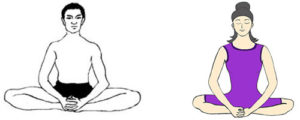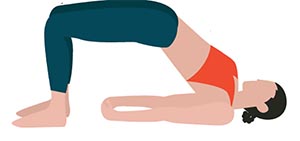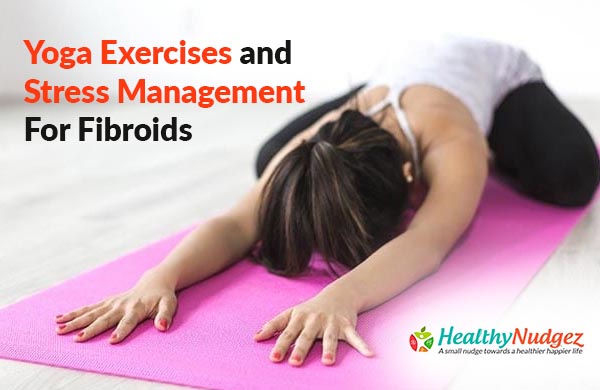Yoga Exercises and Stress Management Techniques for Fibroids
What are fibroids?
Fibroids are non-cancerous growths comprised of either fibrous connective tissue or muscle that develop in or around the womb (uterus Fibroids can grow anywhere in the womb and vary in size considerably. (for more on Fibroids read Fibroids-Not Always Notorious on https://www.healthynudgez.com/category/body-mind-soul/physical-well-being/)
How do fibroids develop?
Several factors may influence their formation, such as hormones and family history.
Fibroids usually develop during a woman’s reproductive years (from around 16 to 50 years of age) when estrogen levels are at their highest.
It’s also thought they occur more often in overweight or obese women because being overweight increases the level of estrogen in the body
What are symptoms of fibroids?
Uterine fibroids can make life difficult, causing symptoms like pain, heavy periods and pelvic cramps.
How to prevent fibroids?
Weight control and diet may help to decrease the risk of fibroids. A diet that limits red meat and is rich in green, leafy vegetables, fruit, and fish may be beneficial. (for more information read – Role of Diet in the Treatment of Fibroids, on www.healthynudgez.com
Yoga poses like Bhadrasana (Butterfly Pose), Supta Virasana (Reclining Hero Pose), Supta Baddha Konasana (Reclining Bound Angle Pose), and Setu Bandha Sarvangasana (Bridge Pose) and breathing exercises and exercises like walking, swimming can be of great benefit.
These exercises help open up the uterus and relieve the congestion and pain in the uterine area. Be aware of exercises that exert a lot of pressure on the lower abdomen.
 Bhadrasana (Butterfly Pose)
Bhadrasana (Butterfly Pose)
- Sit on the floor with legs stretched out.
- Fold both the legs and bring them close to each other. The sole of the feet must touch each other.
- Use the hands to hold the toes of the feet. Pull the legs towards the perineum. The legs should rest on the ground, touching the floor.
- Keep the spine straight and relax the shoulders.
- Maintain this final pose for as long as comfortable. The breathing can be slow and rhythmic.
Contraindications:
- Do not push your knees down with your hands. Just let the stretch happen naturally.
- This yoga pose stretches the muscles under the thighs intensely and must be practiced with care, with the waist and neck remaining erect.
- People suffering from sciatica should not practice Bhadrasana.
Supta Virasana (Reclining Hero Pose)
 Sit in Virasana but sit between your feet rather than on the feet as in the Vajrasana.
Sit in Virasana but sit between your feet rather than on the feet as in the Vajrasana.- Your feet should be just outside your hips, the top of your feet pressing into the floor, and your toes pointing backwards.
- Make sure your knees are not out and are not wider than your hips.
- Recline backwards by first walking back onto your hands, then your elbows, and then if it feels comfortable, onto your back.
- If you feel discomfort in your knees or lower back, or if your knees lift significantly off of the floor, back out of the pose and come more upright.
- For more support, sit on a block or a blanket folded to about the size of a block and support your middle and upper back, neck, and head with blankets.
- Stay in the pose for a minute, and in the future you can practice so that you can stay in the pose for 5-10 minutes.
- To come out of the pose, push yourself up with your hands and return to kneeling in Virasana. Come up to your knees, crossing your legs behind coming into Sukhasana (seated cross-legged pose). Now extend your legs in front of you to stretch them out.
Contraindications:
- Anyone with a history of back, knee, or ankle problems must consult their doctor/yoga expert before attempting this posture.
- Beginners need to perform this pose under supervision of a Yoga teacher.
- Refrain from practicing this pose if you are unable to comfortably sit on your hips easily between the feet.
 Setu Bandha Sarvangasana ( Bridge Pose)
Setu Bandha Sarvangasana ( Bridge Pose)
- Lie on your on your back with the knees bent and the soles of your feet flat on the floor.
- The arms on both the sides and lying on the floor.
- Lift the hips off the floor.
- To come out, gently lower your back to the floor.
Contraindications:
- Do not try or avoid doing this pose if you are suffering from knee neck and back injuries or pain.
- Do the Asana under the supervision of Yoga instructor.
The stress management exercises and lifestyle changes are a very important part of the fibroid HOLISTIC program.
A variety of stress management techniques like meditation and deep breathing exercises, affirmations visualizations, self care and love etc .on regular basis along with physical exercises can help women suffering from fibroids.
Yoga breathing exercises, or Pranayama, may produce similar benefits for uterine fibroids While there are numerous forms of pranayama, breathing exercises that focus on slow, deep breathing like alternate nostril breathing etc. may help you control excess stress.
Meditation :
Many women suffering from fibroids complain of daily life stresses. Stress can lower the pain threshold, increasing muscle tension and discomfort. Meditation helps to combat this stress.
Lie down or sit in a comfortable position, close your eyes and breathe deeply. Let your breathing be slow and relaxed. Notice the movement of your chest and abdomen in and out.
Focus all of your attention on your breathing. If you feel your attention wandering, bring it back to your breathing. By emptying your mind, you give yourself a rest. The metabolism of your body slows down. Meditating gives your mind a break from tension and worry.

